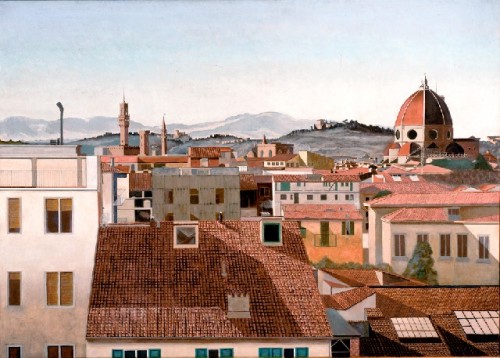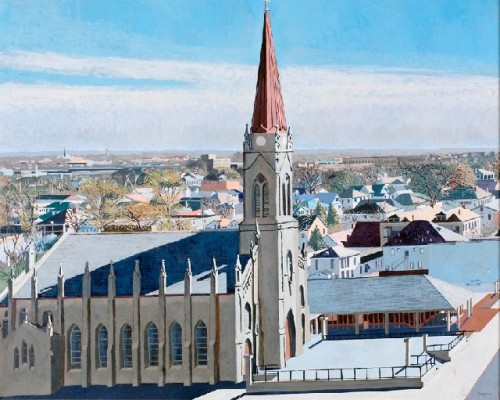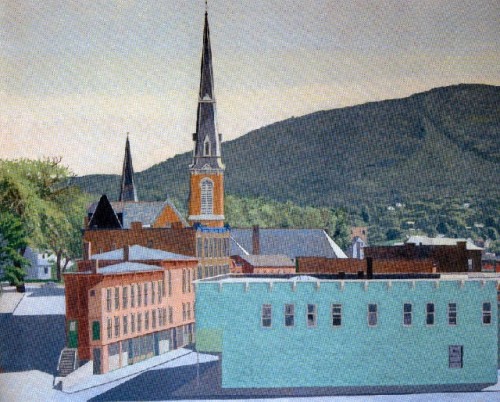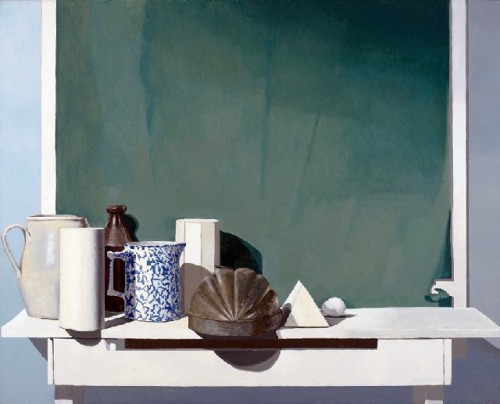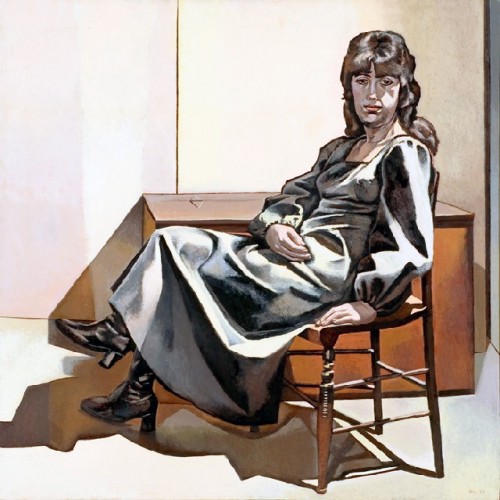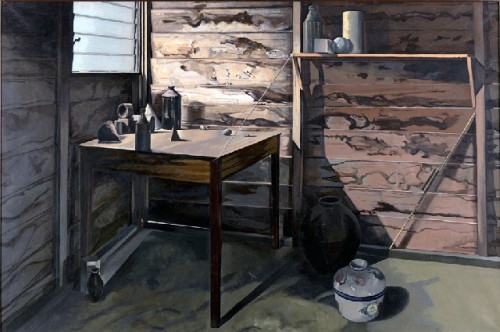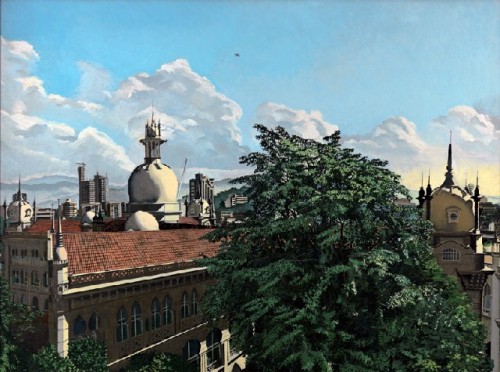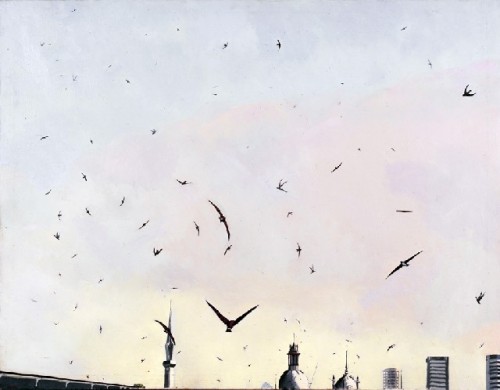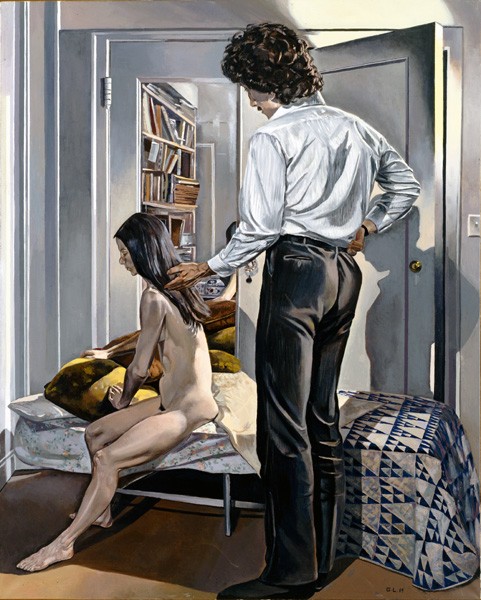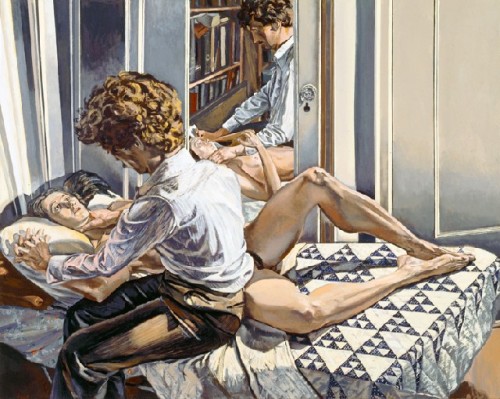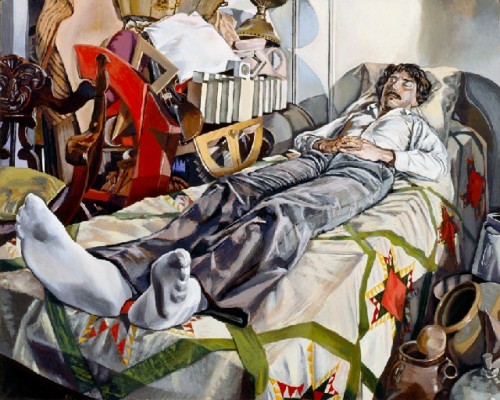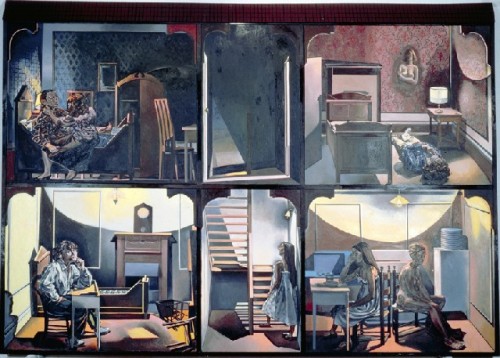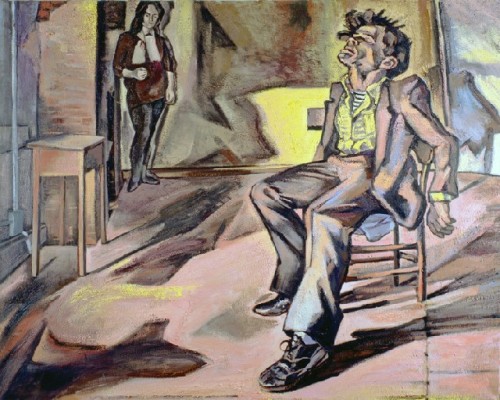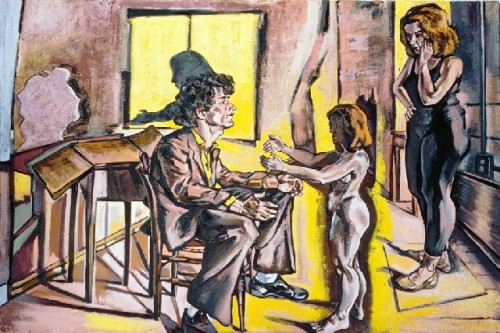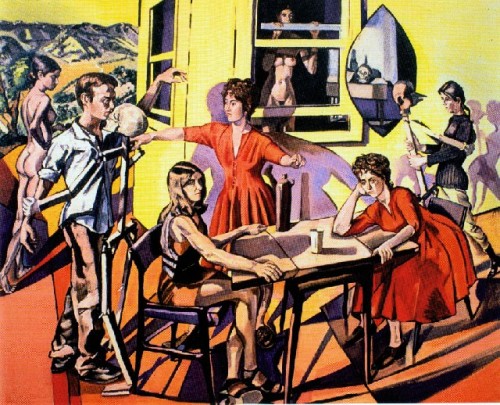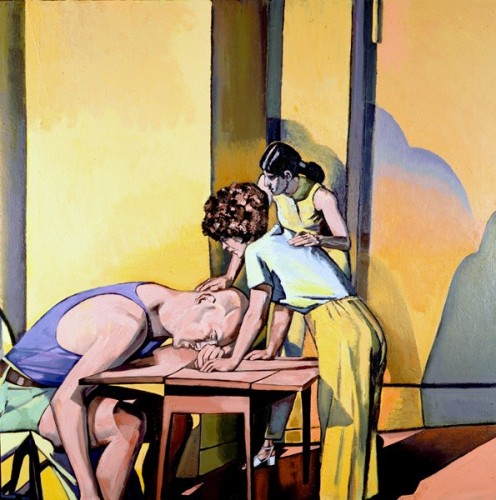Gabriel Laderman: Unconventional Realist
Retrospective at Museum of Art, University of New Hampshire
By: David Carbone and Lincoln Perry - Nov 28, 2008
University of Virginia Art Museum
August 13 to October 12, 2008
Museum of Art, University of New Hampshire
December 1-December 15, 2008
Rosemary Berkel and Harry L. Crisp II Museum
Southeast Missouri State University
January 13- March 15, 2009
New York Academy of Art
March 31 – April 28, 2009
Louisiana State University Museum of Art
September 4- October 25, 2009
Gabriel Laderman: Unconventionbal Realist
Introduction by Langdon Quinn, Essays by David Carbone and Lincoln Perry. 20 Color reproductions, Exhibition Checklist, Resume and Bibliography. Published by the University of New Hampshire, 2008, 62 Pages, $20.00
An Unconventional Realist
Now that figuration has reentered the mainstream of contemporary art, Gabriel Laderman is being celebrated as oneof the most challenging and outstanding painters of the last half century. Laderman is a key figure in the development of postabstract figuration, or new realism, as it was called, during the 1960s and '70s. He became an early and important model as an artist, critic, and theorist for peers and younger painters, here and abroad. Laderman was one of the first painters to reject the conventions of abstract expressionism and collage. In its place, he brought the structural and metaphoric thinking of abstraction to perceptual representation. Standing apart from academic formulas, and from any obvious modernist strategy, he completely rethought figuration.
Laderman was able to draw on and reformulate metaphoric structures from multiple cultural sources—modernism and the early Renaissance, seventeenth-century realism and East Asian art, fusing them into new and contemporary works by experimenting with these ideas as he painted directly from nature. The result is a complex body of work which carries on a dialogue with past art. Just as Laderman's work is conditioned by our awareness of his use of the past, the art past is also changed in our understanding of his work. In this dialogue deeper readings are revealed that transform the idea of tradition in significant ways which have been famously elaborated on by Mikhail Bakhtin and T. S. Eliot. During the halcyon years of criticism in the pages of ARTnews and Artforum, Laderman's writing on figuration explored the potential for originality embedded within neglected aspects of various art traditions.
This exhibition examines four decades of his development as an artist, working with still life, landscape, portraiture, the nude, and narrative. In his early still lifes and landscapes, Laderman tackled the problems of creating paintings as spatial worlds rather than mere images. Emphasizing objectivity, this work suppressed emotional qualities in favor of a 1960s "cool." The quality of light, the visceral geometry of space in depth and as a pattern on the surface, the haunted metaphysical stillness, all contribute to a powerful feeling of fatality. This sensation of mortality runs throughout Laderman's works and suggests the urgent moral force of his work.
Landscapes by Laderman often depict urban American cities seen where mankind's efforts are implicitly set against nature's infinite expanse. Startling and fresh formulations of landscape forms are joined with modernist constructivist ideas to establish a symbolic pictorial dynamic. A factory, an office tower, or a cathedral creates vertical rhythmic intervals that play against he flutter of horizontal branches of foliage while roofs, bridges, and roads stretch back toward the distant horizon. The symbolic dynamic is felt in the pictorial tensions between these elements as they are made stark in the harsh vibration of light.
As his late style emerged, Laderman's work began to swing back and forth between unique hybrid forms; between a metaphysical- naturalist mode and a postcubist expressionism. With such varied works, Laderman was able to join the vehemence of his sensory perceptions to his chief dramatic subjects: death and desire. In precarious scenes of modern lovers, he moves us from unequal loves, to the emotional dwarfing of Oedipal desires, and beyond to Thanatos.
The intensity of these works has been underlined by the refraction of several tragic events: during World War II , Laderman's elder brother was brutally murdered by German peasants when he was forced to parachute from his plane; in the early eighties, Laderman and his wife were witnesses to a murder committed during a robbery; a few years later a model he was working closely with was killed and eaten by a madman; and his wife suffered a near fatal stroke. Laderman himself has lived, somewhat precariously, for more than two decades with leukemia.
There is an ethos in Laderman's work that resists "norms": classical, realist, photo, or pop. Instead of pursuing a sense of beauty or "good taste," Laderman has continuously sought to experiment with the means of representation. He gambles on the modernist strategy of the surprisingly ugly or awkward form to provide us with an awakening jolt to our expectations. In the vertigo of curving space, in the wrenching shifts of forms, and with disjunctive rhythmic movements, Laderman creates a pictorial syntax which mirrors reality not as we agree to see it, but as we feel or know it to be the moment we lose our step.
In his subtle blending of metaforms from twentieth-century
abstraction, the art of Christian Europe, that of China and Japan,
and even the animism of Malaysia, Laderman has enacted,
through his synthesis of aesthetic and cultural enthusiasms, a
distinct and subtle mindset. It is at once radical and conservative,
secular and metaphysical, developing out of the expressive
idealism of modernism and its Freudian inheritance. His recent,
often complex, figure compositions are among the most challenging
and rewarding works produced anywhere in the last
quarter century. Here is a New York painter who has created out
of diverse cultural involvements a distinctly American synthesis,
one that expresses rare qualities in today's art: objectivity and
meditation, empathy and compassion, delirium and dream.
David Carbone
University of Albany, State University of New York
Gabriel Laderman: Cool and Hot
The Context
In New York's art world from the 1960s to the '80s, people
seemed to either love or hate Gabriel Laderman. He could be so
overpowering, his opinions so well informed and thought out,
his delivery so articulate and often so loud that you couldn't just
ignore him. Of course, his work spoke very clearly for itself, and
still does. He appealed to those who were passionately interested
in the breadth and depth of art, and deeply ambitious for art as
an agent of change. And he was not a solitary figure. New York
had become a hotbed not just for the art movements that were
garnering most of the media attention, but for a group of powerfully
vocal and dedicated advocates of a new figuration.
Starting in 1969, figurative artists would periodically meet
at the Educational Alliance, a Jewish community organization
founded in 1893 on the Lower East Side in Manhattan, where one
could participate in shout-fests over issues an outsider might see
as arcane, but which always had a moral correlative. It was as if
political brawls about points of honor still haunted the Alliance's
dusty, history-laden halls. When the larger-than-life personalities
at these get-togethers took positions on such issues as the
linear versus the painterly (which some had the good humor
to call tight versus sloppy), one didn't see gentlemanly debates
on Wölfflin's art historical categories. These were knock-down,
drag-out fights, almost coming to blows. Linear versus painterly?
Why not say moral clarity versus sentimentalized expressionism!
No, on the contrary, we're talking about dutiful rendering
versus emotional honesty! Picasso's neoclassical period?
Work done in bad faith! No, it points the way out of the abstract
woods! Aesthetics and ethics were somehow inseparable when it
came to form making, color, pictorial depth, or narrative.
And though such lines were drawn on principle, powerful
personalities were certainly involved. Aristodimos Kaldis, a selfproclaimed naif, arrived at the party like some Zorbatic Ancient
Mariner, warning all against over-sophistication. Paul Georges
and his beer-guzzling henchmen appropriated the macho muscle
of abstract expressionism and distrusted too much ideation—
perhaps even thought. Leland Bell had his own cohort and
insisted the only acceptable thread of influence came through
Derain to Balthus, Giacometti, and Helion, and any other path
was unacceptable. Not just misguided, but unethical. Bell's magnetic
eyes would bulge dangerously from their sockets as he fulminated
like an angry god, even if his opponent was as elderly
as Alice Neel. "Age makes no difference, Alice!!!" Bell roared
one evening, towering over the aged Circe, while she continued
knitting as if Bell were no more than a hovering fly. Neel loved
getting under other people's skin. Any number of strong women
attended. Some, like Rosemary Beck, happily joined the fray,
breathing the testosterone-laden air, while others, like Louisa
Matthiasdottir, radiated silent authority. Lennart Anderson was
similarly reticent, distancing himself from the Sturm und Drang,
for his was a diffident stance, both modest and arrogant. "I'm not
so good," he would say, "but everyone else is worse."
Robert Rosenblum came to the Alliance to speak about an
exhibition he curated at the Metropolitan Museum of Art, French
Painting 1774–1830: The Age of Revolution. The premise of the
show was that much more goes on in any historical period than
is written into the record, and while his remarks should have
given some of the more thuggish artists hope that their work
might be resuscitated by such a show in the future, personal
epithets were hurled at the urbane art historian. "They told me
it would be like this!" he exclaimed delightedly. "What fun!"
Rosenblum gave as good as he got.
One of the principal contestants was always Gabriel
Laderman. In those days, he tended to dress in denim overalls
like a train engineer, his long hair sticking out beneath a crumpled
cap that covered his balding head. His Cheshire Cat grin,
marked by a gap between his front teeth, would hover in the
air long after such meetings adjourned. Certainly, his eloquent
arguments lingered in audiences' minds for years to come. But
the Alliance wasn't just a battlefield for these figurative artists.
There were also sweet interactions, as when Leland Bell would
fill a carousel tray with slides of paintings that Laderman would
then respond to off the cuff. After perhaps ten slides, Gabriel
would say, "Ah, I see what you're up to," since the slide sequence
would always have an agenda designed to trap or delight. The
next week Gabriel might do the same for Leland. One could see
the genuine affection and respect they felt for each other. And
even when Laderman did lose control, as often as not he would
be contrite just minutes later, sheepishly wondering if he had
hurt anyone's feelings.
The Alliance was heady stuff, and perfect for a younger
painter, because while Laderman spoke of a life well lived in art,
that had nothing to do with having a career. It was as if the soul
of the world hung in the balance, and we all had to take responsibility
for what our work would mean. After all, our country
was then embroiled in a catastrophic military debacle halfway
around the world; the government was not to be trusted; and
people had taken to the streets. Issues, even artistic ones, were
all interrelated. One had to take a stand.
The Teacher
Something similar applied at Queens College, where Laderman
taught from 1967 to 1996. Students tended to dread visits from
the "Gang of Five," the group of painter/professors who prowled
from studio to studio giving critiques, likely to spend as much
energy dissecting each other as one's work. If Elias Friedensohn
was on your committee, one could hear sotto voce warnings, "Eli's
coming, better hide your art," and God help you if Laderman and
Louie Finkelstein entered your studio together. Students tended
to pledge allegiance to one or the other, or, more accurately, if
you spent more time with Gabriel, Louie would avoid you like
the plague. Like Mutt and Jeff, or a squabbling Don Quixote
and Sancho Panza, the tall, skinny Finkelstein would put a hand
over his heart on hearing what the shorter, rounder Laderman
had to say, warning that this had to stop before he had another
heart attack. Their joint critiques resembled the battle between
Carnival and Lent, though they took turns alternately personifying
Lenten rigor or carnivalesque outrageousness. We were in
art boot camp, one filled with blustering, red-faced, merciless
sergeants. The acoustics of the art building, a huge Quonset hut
left over from World War II , let us hear shouts from ongoing
critiques, as when Gabriel yelled at a grad student for being
STU PID !!! Being a feisty New Yorker, the student yelled right
back, ordering him to Get the hell out of my studio NOW!
Even the more subdued Robert Birmelin could be heard
yelling the "S" word when a student provocatively said he only
painted the way he did because his teachers at Kansas City
Art Institute's undergrad program had told him to. And when
Lennart Anderson came from Brooklyn College to give private
crits, he announced he didn't like anything he saw, and even
advised one kid to drop out for his own good. This was a sinkor-
swim program, and I felt extremely lucky to be there.
I lived on West End Avenue across from the apartment where
Laderman and his family have lived for decades. Four times a
week I would catch a ride with Gabriel out to Queens College,
the graduate program I had expressly chosen in order to shadow
his every move. As his assistant, I saw him teach, and I went on
to use some of his approaches in my subsequent teaching at the
college level. Yet Queens undergrads seemed not to know what
to make of the alternately grinning and shouting, kindly and
fearsome figure who stood before them, a New York version of
Buddha/Kali. Laderman's generation grew up on the passions of
the thirties, a world where comrades, inches away on the political
spectrum, might be more reviled than polar opposites, and this
intensity carried over to their art. On my rides out to Queens, I
was more likely to hear quite specific objections to a recent show
by one of his colleagues than a diatribe about someone at the
other end of the spectrum, like Donald Judd or Andy Warhol.
Over the years, Gabriel seems to have mellowed somewhat, and
his current blog favors praise over blame.
I apprenticed myself informally to Gabriel in an effort to
internalize his thought processes. Clearly he had his biases and
considered the metaphorical implications of pictorial structure
paramount, shying away from emotional content. After all, his
generation was reacting against the often intentionally inarticulate
emotionalism of their elders, the pursuit of the ineffable that
too often worked as a dodge for teachers who had nothing much
to offer. Laderman assumed students would bring their own
stories to the work and that his job was to make them visually
literate enough to find a voice for what they had to say.
In addressing issues of spatial organization, Laderman faced
any number of misunderstandings shared by the whole culture,
including the assumption that pictorial space automatically
means the use of perspective. This speaks to the general lack
of understanding of the vast array of choices developed over
time and in widespread cultures for making pictorial worlds.
Laderman taught one approach to pictorial architecture that I
continue to find both very useful and liberating as a seed for
other fruit. Gabriel's students were made to consider a spectrum
from highly conceptualized drawing, as if from the mind's eye, to
an approach as closely based on careful observation as possible.
Like other artist/teachers seeking some continuity with recent
tradition and connection to observed nature, he stressed the
perceptual drawing of Cézanne, where one concentrates on and
draws only the small visual incidents defined by plane changes
or overlaps. The resulting meander through space carves a path
into depth that has no preconceived goal or overriding organization.
If perspective posits a box of space to be filled with obedient
and discrete objects, Cézanne's approach lets space be created by
the act of looking, where there are no objects per se, only visual
footholds that allow us to climb up and into depth. If students
work carefully in this snail's trail way, inevitably their initial and
final marks will not correlate in any perspectival sense.
Whether we find the distortions in Cézanne's work exhilarating,
disturbing, or some mixture of the two, the shifts, tilts,
and splits before our eyes build a subtle pictorial analogy for
the processes of perception. As one carves an arabesque into
depth and back out again, these little plane changes and overlaps
start to cohere as spatial locations sequentially identifiable
as close, middle, far, middle, and back out to close. Since that
which is lower tends to be read as closer, Laderman suggested
students look for pictorial pressures that push down and therefore
forward on one or the other side of their sheet of paper. If
a vertical is felt or found somewhere near the page's center, one
could then literalize this shift by cutting the paper and moving
the close half down, exaggerating the sensation of proximity.
Taping the pieces together, one can then find a horizontal axis
and cut and shift accordingly as in the above diagram.
Having gradually gone from small, local overlaps observed in
the motif to four simplified overlapping spatial zones, students
would then look for pressures near the periphery of the format
that made for a crunching shift near the center, somewhat the
way tectonic plates build and release tremendous pent up pressure.
Laderman would show them works by Vermeer, Ingres,
Courbet, and Cézanne that all share this underlying nonperspectival
order.
The better students not only got some sense of surface shifts
as communicating implied spatial pushes, but a sense that any
number of other similarly subtle approaches to space can be
found as well. For Gabriel never presented this as some arcane
secret key to art, but as a vivid metaphor, somewhat the way the
French theorist Roger de Piles described Rubens's work as often
resembling a bunch of grapes, which curves toward us not just
in the aggregate but as a collection of smaller, bulging centers
of interest. Students need this kind of common-sense, sensate
analogy in order to proceed, and that was where Gabriel always
came through. Theory for its own sake was of no particular
interest. Anything that would help students go forth and think
for themselves was carefully cultivated. A significant number of
people studied with Gabriel, and I would guess that not a single
one of them ever forgot the experience.
The Painter: Early Work
But even if Laderman enjoyed the occasional fight at the Alliance,
and if his social conscience led him to help educate succeeding
generations, painters live to paint. He was part of the robust
international postwar effort to find ways to reinform the figure, an effort overshadowed by the noisy success of abstract expressionism.
Early on Laderman read Klee's Pedagogical Sketchbook and studied with Hans Hofmann and de Kooning in an effort to find pictorial structures that could contribute to a new, postabstract figuration. His teachers were anything but doctrinaire and drew on a vast range of world art.
Ad Reinhardt pointed out how curving Arabic calligraphy played off against the often severe symmetry of Islamic architecture. He showed what Laderman recalls as "slides of the interiors of Hindu and Buddhist temples that were so dark it was almost impossible to make out the figures," which shed light on Reinhardt's black paintings.
Others gave hard-headed exercises in finding structures in
the overlooked: "Alfred Russell had us not only drawing in the
Natural History museum," writes Laderman, "but also highly
touted the value of drawing parked cars, looking through the
windows into the internal spaces, and those as seen in a second
car through a first one." In his own work, Russell, a painter/
teacher Laderman greatly admired, replaced Albertian perspective
with non-Euclidean geometry as the locale for his haunted,
invented, falling figures. As a teacher, Russell stressed immersing
oneself in the nonobjective art idiom as a way to reinvigorate
figuration, while avoiding the academic varieties of realism, or
those that superficially borrow the look of abstraction. Russell
could be wry: "The challenge of drawing and painting the figure
is a formidable one, enough to have occupied the whole history
of civilization; certainly it will be enough to occupy me as a
painter." Or he could throw Nietzschean thunderbolts: "I believe
one must be out of key with the times in order to see them at
all: one must always be against the grain and never forget his
contempt for the botched and bungled mob." He would regularly
reduce graduate students to tears, for it was like studying with
someone as mad and brilliant as Ezra Pound. Even Laderman
found him intimidating.
A young painter's first European trip, where the figurative
tradition hits you in the face like a frying pan, has to be equally
intimidating. But a year in Italy on a Fulbright in 1962 seemed to
clarify the issues for Laderman, who returned with the huge and
powerful View of Florence (fig. 1). For me, it evokes Canaletto's
Stonemason's Yard from 1727, roughly the same size, also an
Italian cityscape, and also carefully using planar echoes of the
picture plane as we step back into space. In particular, both
paintings let spatial locations, separated by depth, kiss on the
picture plane, letting large shadow diagonals assert shapes on
the surface as well as carrying us into depth. In View of Florence,
the little dance of triangular shapes in the lower right roofs is a
wonderfully cubistic moment. But while Laderman dares to care
about past art, this is not pastiche in any sense. He is announcing
a new visual order as startling inits way as the work of Frank Stella or
Donald Judd. This is a high level of pictorial intelligence brought to bear on the visible world, but it is also a manifesto of sorts, a glove thrown down to the New York art world. And it quickly finds American expression in the landscapes done in New Orleans and North
Adams on his return.
The work from the sixties, such as Still Life #2, Homage to David (1969, fig. 2), looks cool, even austere. And how can we reconcile this austerity with his later work? Laderman feels it is all of a piece, and the more we look at the body of work, the more we can see it as all shaped by the same sensibility. The title of Laderman's painting cues us to remember Jacques-Louis David's Death of Marat (1793, fig. 3). We notice myriad shared traits: a clinical white light falls from the upper left, a large relatively unmodulated dark shape hovers above and behind a
series of forms. These forms are subtly analogous in themselves.
For Marat's head, the jug to the far left; for his arm, the vertical
white cylinder; and so on until the gelatin mold that projects out
reminds us of Marat's box/writing desk. Interestingly, by this
reading the egg in the still life, the only organic form we find, is
analogous to the letter from Charlotte Corday that seals the revolutionary's fate. Is this all just cleverness, an in-joke? Consider
when Laderman's painting was done: 1969, right after Martin
Luther King Jr. and Robert Kennedy were shot and killed.
All three leaders, Marat, King, and Kennedy, were assassinated
in times of unpredictable change, of fervor, division, and rancor. These works by David and Laderman share an elegiac tone, a sense that tragedy is best seen with realistic clarity. They have an almost fatalistically geometric inevitability, as if we are all locked in to a big, cosmic picture. Again and again for Laderman, still-life objects and configurations are stand-ins for much larger forces.
Something similarly metaphysical haunts the View of North
Adams (1968, fig. 4) from about the same time, a work that shares
some of the ghost-town quality of Hopper's iconic Early Sunday
Morning. While Hopper and Laderman locate themselves to face
a planar wall of buildings, the latter places himself higher and
farther away, making the landscape resemble a self-contained
still life. As in the View of Florence, different spatial locations both
open up and pinch to the surface in the View of North Adams: the
left edge of the aqua-blue building lines up with edges and plane
changes farther back, so the intervening street is both credibly
navigable and blocked by surface pattern. This turquoise foreground
rectangle seems to hover up to the picture plane, partly
because of its color weight (something Laderman learned from
Hoffman), partly because its cast shadow helps it mimic a basrelief.
I find this geometry reassuring, as if a reliable order can
be found in, or made of, the world.
These early paintings, bathed in their cool white light, show a
profound interest in combining the observed with some underlying
order. Laderman was always interested in perception's tug of war with conception and had the odd gift of a Cézannelike hand that made subtle distortions flow naturally into his constructed spaces. If nature and nurture filter our perception, then some will classicize or idealize what they see, while others resist such cleaning up, finding an expressionism based on both making and finding.
Consider the huge jug in Laderman's Still Life with Large Ceramic
Jug (1972, fig. 5). On the left it sags as if pregnant, almost touching
the table leg, while on the right it lifts like a hot-air balloon,
nudging our eye up along the format's right edge. This may be
the product of the incremental working method he taught in
class, and such distortions certainly show up in Chardin and
Cézanne, painters resisting the conceptualized, cleaned-up symmetry of those who want to get it "right." Yet the table suggests something even odder. If the jug seems stretched back and to the right, the table appears to pull us up and into depth on thel eft. One can argue that the world seems to expand out and away from us as credibly or sensibly as it contracts to a vanishing point. Laderman's still life encourages such a reading, for his table expands rather than shrinking as it recedes to the left. (Not) to mention the legs, which splay as they go down.) And then the relentlessly white rectangularity of the side of the table seems to pull us back out to the surface at the same time it promises recession.
Perhaps this tension helps explain some of our unease as we
stand before this work. People quickly notice the limited palette,
which works as warm and cool, based on an overall pink tonality.
The analytic cubists similarly avoided saturated color as a
part of their controlled formal experimentation. Juan Gris would
be happy with these large unmodulated shapes, alternately
tipping us in and out of space and hugging the surface. For just
as we start to accept the harsh realism of this still life with jug,
Laderman undercuts the promise of rationality with a teasing
sense of unease. Objectivity is first posited, then withdrawn.
The more we assume we know, the less we really do. Finally,
for this viewer, there is something anthropomorphic about all of
these interactions, as if a large, solid man looks up at a world of lesser beings who try to lord it over him, but still stands free of their shadow.
One is tempted to consider the jug a kindred spirit with Brunelleschi's dome in the View of Florence, or to see them both as symbolic selfportraits.
Similar thinking applies in Portrait of Johanna (1972, fig. 6). Shifts in the box, the wall, and the chair's architecture result from Laderman's rigorously perceptual approach and are accepted as pictorial pressures, reminding us of the shifting squares diagram (see page 8). Using its logic, we find an implied vertical running down through her right hand. Since the right half of the space is generally closer, look for pressure up and back on the left, here suggested by the harsh shadow line at Johanna's feet. This push is answered by implied pressure down on her head, relative to the top edge of the painting. Now cut a horizontal through her lap, look for completion of the circuit in a vertical in the upper left (the shadow line or the wall division), pushing us to the right. This is answered by the push we get to the left in the form of the vertical rear chair leg. Literalize these quadrants as chair—close, Johanna's leg—middle, wall—far, torso—middle, back to where we began. In fact, her slumping posture and raised leg cooperate nicely in this overall shift, as her pose becomes a sort of whirling cross, all rotating around the pivotal hand in her lap. We can also see the overall organization as bulging toward us and curving away on the periphery and find any number of subtle pictorial surprises here. As viewers we're not always asked to delineate, or even to consciously register, pictorial mechanics, any more than we necessarily follow the sonata form's structural intricacies as we listen to Bach. However, at times, as in the Large Malaysian Still Life (1976, fig. 7), where the shifting squares become quite clear, structure itself is advertised for poetic reasons and with
cosmological allusions.
We come back to the malaise mentioned earlier, this queasy
undertone. Johanna is not idealized or particularly attractive,
and she sits alone on a harshly lit stage like a character from a
Beckett play. With no social or domestic context, no attributes to
clarify her role or identity, she is emotionally naked, confronted
by a viewer/artist who projects onto her and even shares her
fatalistic wait. Outlined in the kind of brittle light that makes
Morandi's early still lifes into metaphysical poems, she is locked
into her own shadow, her own stark world, as a volumetric silhouette.
Like Joe Friday in the old TV show, Dragnet, we think
we're getting "just the facts ma'am, nothing but the facts," a no-
nonsense American literalism. But why do we feel so uneasy?
Especially in this early work we feel a kind of one-two punch,
suckered in by objectivity until the subjectivity at the core of
experience begins to haunt us.
The Painter: Later Work
In 1975, Laderman accompanied his anthropologist wife, Carol,
to Malaysia, where she was doing work on childbirth and studying
an indigenous pre-Islamic system of hot and cool humors in
shamanistic medicine. In Malaysia a shaman asked Laderman
what painting was for. "To change people," said Gabriel. "Does
it work?" asked the shaman. Apparently getting away from the
New York art world was in itself life-changing for Laderman.
True, taking the Lincoln Tunnel to New Jersey takes you to a
world that could not possibly care less about the arcana of the
art scene in Manhattan or Brooklyn. But when a wise man from
a totally unfamiliar culture asks about the activity you've been
immersed in all your life, wanting to know what it's for, and
whether it works, you take the question seriously.
View of Kuala Lumpur with Birds (1982, fig. 8), is as lighthearted
as its subject. Gabriel identifies with these birds, perhaps feeling
freed from the occasionally smug provincialism of New York.
They seem like Jackson Pollocks done after nature, describing
or implying loopy trajectories, a touching tribute to free spirits
caught on the fly. Coming back from Malaysia, Laderman spoke
of things he might have disdained in the past, such as alpha
waves and meditation. An experiment had impressed him, one
that hooked up artists to monitors. Apparently, when deeply
engaged in painting, their brain waves were indistinguishable
from those of people meditating. The Ladermans' son, Michael,
had suffered from what they were told was an incurable malady,
but had been verifiably helped by a Malaysian faith healer, and Carol had benefited from going into a trance at the hands of a shaman practicing a type of precognitive therapy. It appeared that Laderman's two sides, the cool, deeply rational man and the expressionist
hot head, could be reconciled as if by magic. And that magic could be given form through art. Art isn't therapy for the artist, but it helps make sense of an errant and elusive world. After Malaysia, Laderman's work became more and more thoughtfully wild or wildly thoughtful.
Another wry comment on his own nature might be found
in Still Life with Order and Chaos (1983–84, fig. 9, location
unknown). Any visitor to Laderman's apartment or studio would
know the chaos part came easily, and the order is clear just in
the act of painting. Chaos theory tries to find the point at which
order, like a quiet thread of cigarette smoke, devolves into randomness,
as when the smoke begins to curl into unpredictable swirls. Physicist David Bohm's idea of implicate order, one that finds flow as preexisting the "things" that form and dissolve into this flow, might also be applied to the human detritus in the neglected corners of our lives. We could again read this still life as a surrogate self-portrait, and in fact Gabriel's leg shows up in the mirror to the far left, draped in the checkered batik material he tended to favor after living in Malaysia. Order and chaos, cool and hot, life and death; Emerson and Whitman famously asked us to take such seeming contradictions and to grow because of them, to encompass multitudes.
At this time, Laderman began a whole series of powerful paintings based on mystery novels. Working on narratives of crime was
not a self-consciously canny strategy: Gabrie and Carol had personally witnessed a murde in a convenience store on the Upper West Side. Violence, like class or race, is inherent in our history, whether we like it or not. At first, as in 1984's three-part Murder and Its Consequences
(fig. 10), Laderman's white light of careful observation falls on
a clinically clear sequence. There are foreshortenings that place
us physically in the space and emotionally in the mind of the
criminal. Goya's Disasters of War, with their captions, "I saw this"
or "This happens," share Laderman's stark realism, the sense of
being implicated in human cruelty. But with The House of Death
and Life (1984–85, fig. 11), a process implicit from the beginning
starts to manifest itself more and more emphatically.
Being a collector, Gabriel bought a large antique doll house,
thinking it would serve as the proscenium stage for a complex
narrative, and put it in one of the rabbit-warren rooms of his
West End Avenue apartment. There it stayed for years, languishing
amidst the chaotic clutter, until he read the work of Georges Simenon, the French detective writer, at which point the neglected doll house came into its own. Most of us are probably unfamiliar with Simenon's Maigret and the Spinster, and as a result, we become the detective as we face this multipanel painting, puzzling out just what is going on. A murder appears to be taking place in the upper left room, and two witnesses apparently hear noises above them. A prone man dreams or hallucinates a woman's naked torso, while under him two women share a kitchen. There's enough symmetry, polarization, and doubling here to make the anthropologist Lévi-Strauss feel right at home. A dysfunctional home. And like the anthropologist, we seek some structuralist logic, coming up with readings the way we do when we "read" the gridlike panels of Duccio's Maesta or a Torres-GarcÃa painting.
Pairs and dichotomies abound. Two women above one sitting
man are diagonally across from two women below one prone
man. The first female pair is intimate in the act of strangulation,
the latter alienated and avoiding contact. The lower left
man is alert, sensing trouble in the present, the upper right man
is presumably asleep, perhaps dreaming of past or future love.
Upstairs the light is dim, the shadows soft, at least in contrast
to the klieg light penumbras below, as if light itself is a major
clue. We sense conscious clarity versus murky desire. Death to
the upper left, love to the upper right. Shards of light are clues
as informative as all the chairs, some relentlessly vertical, some
knocked about at random. Then there are the poles of hot and
cool, epitomized by the kitchen's ironically hot icebox and cool
stove, which finds some echo in the women themselves. If the
(stove) woman in the nightgown is overall cool, she emerges into
the hall as our rational detective-proxy, out to solve the dollhouse
crime. More clues emerge gradually. Why is our view so
close to floor level in one room, while the neighboring floor tilts
up dramatically to meet our eye? What of the scale changes from
figure to figure and the huge heads some of them have? The
upper hallway becomes an emblem for the whole quiet mystery,
resonating like an early de Chirico. The murder itself is so quiet
we begin to strain our ears the way the witnesses do.
The polarities in The House of Death and Life might remind
us of the world-view described by Gabriel's wife, Carol, in her
books on the humoral system of the Malay shaman. Poles of
"cool" and "hot" govern a complex cosmological, social, and
medical system intriguing both on its literal and metaphoric
levels. Echoes might be found in Western dichotomies: those
of Nietzsche (Apollonian and Dionysian), Freud, Lévi-Strauss,
or Mondrian (the theosophical implications of horizontal and
vertical). In the Malay system, "cold" is healthy and life giving,
but is balanced by "hot," which, while associated with excrement,
misfortune, and death, is necessary for the whole. Angin,
the term for the varieties of wind that blow "hot" or "cold," determines
all forms of health, from the individual to the cosmic. This pre-Islamic Malay system has long diagnosed an ill wind of increasing
heat and unhealthiness (and this, even before global warming). The minduk is the master of the inner winds, the interpreter
of the shaman's trances, and here Carol Laderman's studies could apply to her husband's way of seeing. Buddhists call the human body the "burning house." Laderman's painting suggests a bicameral mind, a conflicted body, a house divided against itself. Then again, it might evoke the minduk's ability to reconcile opposites. In any case, a shift becomes apparent in Laderman's work with this painting. From the start he is a rational man filled with passionate intensity. Now cool edges over into hot as some personal sluice is opened.
Family Romance I (1988–89, fig. 12) is clearly by the same
man who painted Portrait of Johanna, for the simplifications,
distortions, and animated shadows remain, if in a heightened
state. The space in both works shears away diagonally on either
side of a central entry. Narrative has entered the later picture,
making the artist a kind of director, staging a play in which the
actors are absorbed in their drama rather than addressing the
viewer/painter. I read this as a cast of two, with the nude being
a homuncular version of the clothed woman, perhaps even a
fantasy in one or both characters' minds. If we cover this nude, the
rest of the space may still be strange, but it becomes easily legible, so she seems purposely disjunctive both spatially and psychologically. There is a parallel to the interaction of man and nude in the shadow play
farther back, where she grows from his hirsute head to reach toward his antishadow with a little wolf-like hand. Both her yellow square of
light, which fails to follow the plane change marked out by the floor molding, and the black aura that surrounds her, take the nude into another order of being, whether it be dream, memory, or wish fulfillment.
Given the painting's title, we're cued to think of Freud's term
for the process of individuation within the family. The good
doctor tells us that the child feels a sexual attraction for the parent
of the opposite gender, so one might read this as the now grown
male child craving the attentions of his mother or perhaps the
woman recalling her craving for her father. Of course, there may
be other readings. Since the clothed man and woman seem to
look at each other, this nude may be something coming between
them and is not necessarily what he opens his arms to receive.
The availability of multiple readings contributes to the dreamlike
aspect of the whole, making the performance leave the stage
and enter the subconscious. Never noticeably fond of the surrealists,
Laderman does seem to borrow their use of credible, if
disjunctive objectivity to remind us how dreams feel. And if the
shadow play to the left owes something to surrealism, then late
Braque or early Morandi comes to mind as holding our feet to
the metaphysical fire. The wild and wonderful table below the
somehow solid yet negative shadow of the man's head may hold
the whole painting in microcosm. We may work to decipher or
disentangle the table legs and their spidery shadows or let their
complexity capture us the way the narrative's questions do.
This Happens (1996–97, fig. 13) also might make us wonder
who is actually here, who is doing the perceiving. What or who
casts the shadows, which dance on the wall like the mountains
in a Chinese brush painting? The big man may be our surrogate,
so that as he loses consciousness the women shrink into a false
distance, a psychological inaccessibility. While these women
seem compassionate, Laderman's title evokes the terse summaries
below each image of Goya's Disasters of War, the series
of etchings about folly, cruelty, and death. Gabriel has suffered
from a rare form of leukemia for some time now, and though
he has managed to keep it at bay, he must be more haunted by
death than those of us still convinced we have time to burn.
We recall the shaman's question when we read Annie Dillard:
"Write as if you were dying. At the same time, assume you write
for an audience consisting solely of terminal patients. That is,
after all, the case. What would you begin writing if you knew
you would die soon? What could you say to a dying person that
would not enrage by its triviality?"
The Writer
In articles published from 1966 on and more recently in his
blog, Laderman has put significant effort into writing about the
problems faced by serious artists. Several generations of painters
interested in what Laderman calls unconventional realism, or
more recently, post-abstract figuration, have looked to him as
a mentor, a somewhat cantankerous father figure. "Being and
Becoming" (Art Journal, Winter 1966) describes what Laderman
considered two ultimately misleading theoretical options at the
time. "Being" describes an approach which detaches art from its
context in history and in the experiential world and makes it
seem impersonally pure, as if quality can somehow be abstracted
or detached from individual works of art. "Becoming" makes the
artist a genius who rejects his time and place, pulling spectacular
rabbits out of a self-created hat. But whether reduced to a cipher
or elevated to some otherworldly height, the artist is removed
from his "daily, plodding practice." Both viewpoints misunderstand
tradition, treating it either as a "weight of formulas to be
followed impersonally toward art" or as "outworn practices to
be discarded or broken through." But if "being" can be traced to
Parmenides, and "becoming" to Heraclitus, Laderman proposes
a third, atomic model out of Democritus. Such a model sees each
painting as an individual "atom," important in itself, with an artist's life work as a molecule within the super molecules of the body of world art. "Tradition, no longer oppressive, becomes breathable atmosphere. The
artist picks and chooses among the 'atoms' of history. An evolution is now possible in which backward glance, individual idiosyncrasy, and representation of nature form one process."
Laderman concludes, "Consciousness of the action of tradition is a necessity if the artist does not wish to remain tossed by the winds
of change or trapped in the stasis of absolute direction and prohibition." This latter trap reminds one of the prescriptive power enjoyed at the time by Clement Greenberg. As Laderman points out, theories of "being" and "becoming" come to share an ahistorical rootlessness that
deprives the artist of genuine volition. And history is at the root
of Laderman's project—a profound conception of continuity that also allows for innovation. Cézanne also from 1966. Clearly, one can sense his identification with artists rebelling against the art world of their own day: Ni Tsan and Huang Kung-wang were two of the five revolutionaries of Yüan painting. They revolted against traditional Sung landscape painting, by then over-conventionalized, codified landscape composition painting in the studio without reference to nature.
. . . Ni Tsan and his friends rejected, in proto-bohemian revolt, the whole official social trappings of art, became vagabonds and painted directly from nature. Their work has little orthodox meditational value; there is no road, there are no houses for meditation. On the other hand, it is possible to move from point to point, from stroke to stroke, from land form to land form, experiencing a spatiality reminiscent of the late
Cézanne oils and watercolors. Their stroke, too, tends to become unvaried and concentrates on spatial flow rather than on object representation. The eye flows over the forms into deep recession with an effect of spatial realism never achieved before or afterwards
in Chinese painting. . . . The similarity of their work and Cézanne's is the result of similarity of process and similarity of discoveries in the face of nature.
Laderman sees us caught in a quagmire of denatured conventionality
analogous to that faced by other artists in history such as the Yüan brush painters, Giotto, the Carracci, Caravaggio, or by Cézanne himself. Like Antaeus, who regained his strength every time he touched the ground, these painters revivified art by returning to nature while informed by deep familiarity with their tradition. We tend to underrate the sophistication of artists of the past; even Clement Greenberg seemed to think that "old style" painting's sole aim was to perfect illusion as if slouching toward protophotography. Laderman had students read John White's brilliant The Birth and Rebirth of Pictorial Space, which made it very clear that early Renaissance artists were highly conscious of the surface and of preventing runaway recession into depth.
Such awareness runs all through our tradition and is hardly
a twentieth-century invention. As a student in the early 1970s, I
remember reading Gabriel's analysis of Corot's The Mantes Bridge
in a piece called "The Outer Light" (Art News Annual, November
1969). There he draws attention to the curving trunks of foreground
trees that assert the picture plane but also link up to more distant forms such as the arches of the bridge, making an elastic conversation between surface and depth. The red color note of the distant man in the boat pulls to the surface through its saturation and scale while the greatest tonal contrast is reserved for the ostensibly most distant zone, the houses in the upper left.
Laderman spoke of the nuts and bolts options in picture
making as well as their underlying metaphoric or poetic implications.
He presciently pointed out in 1970 ("Notes from the
Underground") that the extremely long learning curve involved
in this process of studio self-education did not jibe well with
academic programs: "Just as the tendency in colleges is to teach
that part of art which can most easily be expressed verbally and
to value it most highly, the tendency of critics will be to value
that art most highly which gives their words the most play." His
was a very hands-on, careful exercise in vision, as we can see in
"The Outer Light": Even the most technically conservative landscape
painters were affected by the process of painting and studying from nature. Thomas Cole, in his early studies . . . decided emphatically that the outline of the forms should be arrived at only through a slow
development of the interior, this in total disregard of Ingres's dictum that "line is the probity of art." The palette knife of Courbet, which he used to develop the volumes and spaces implicit in the shapes before
them, became itself in many of his paintings a normative mark which defined small planes traveling through space and united the painting into an object of unified texture.
The French Academy was founded in 1648 partly to elevate
painting from a craft to a liberal art, so there is a history to
denigrating studio practice in favor of philosophizing. By shoehorning
the visual arts into Aristotle's Poetics, the academy
tended to make painting literary and ideational. But Laderman
reminds us how the beast is actually born, as here from the
same article: Cézanne . . . did not use . . . hues only to arrive at
chromatic equivalents of the lights, middle tones and
darks which explain form, but instead for independent
planar investigations of the forms in space presented
to him by his motif. He used little planes of color traveling
over forms and spaces in independent paths to describe the volumes and spaces observed. The independence from one another of their pictorial paths led to distortions of the outlines of forms. These were constantly reworked by the same procedure in a search for simplicity and monumentality. This procedure was responsible for the new plasticity, new not only to Cézanne, but, in this form, to the history of art.
If you're trying to paint, this is the kind of help you need.
Laderman's atomic model is also highly consoling. In "The
Future of Landscape Painting" (Artforum, November 1968), he
wrote: "Generations of pictorial solutions are available to us; . . .
the representational painter . . . should recognize that there are
no viable rules and boundaries to his activity and proclaim his
freedom by discovering and inventing the ones he needs to make
a viable poetic statement." He ended with an extended quote
from Kuo Hsi, an eleventh-century Sung painter who describes
a beautiful landscape as seen by a lover of forest and stream,
which concludes: "Does not such a scene satisfy his mind and
captivate his heart? That is why the world values the true significance
of the painting of mountains. If this is not recognized,
and the landscapes are roughly and carelessly approached, then
is it not like spoiling a magnificent view and polluting the pure
wind?"
One thinks of the current argument as to whether beauty is
somehow misleading, a dishonest distraction from the cruelty
around us. A man writing almost a millennium ago is warning
us that art is our self-portrait as a species, and that we can pollute
our art as easily as we pollute our world. In a letter further clarifying
his "Notes from the Underground" (Artforum, September
1970), Laderman wrote: Rather than proselytizing for figuration exclusively I try to proselytize for an art of feeling, sensibility,
and knowledge, whether figurative or abstract. . . . It
is surely untenable for a contemporary artist or critic
to think of art history in linear terms as a one- or two-way street. The linearity we prize is a useful construct of the art historians, but all the objects remain to be reexperienced and reinterpreted by those artists
who do not fear history and do not need the crutch of a narrow contemporary self-congratulating elite to bolster their egos.
The article makes it clear that innovation (which incorporates
feeling, sensibility, and knowledge) is essential: Virgil Thompson, writing some years ago in Encounter, said that if we divide the twentieth century into fifteen- year intervals, the amount of innovation within
these decreases as they approach the present. This can
be seen even more acutely in the art of the last ten years. Thompson continues to say that in the future, instead of quality following the new, the new will have to follow quality. I would go further and say that the
new, which is the elite art of today, will have to develop
more slowly if it is to be truly new. Artists must be given time to develop their eccentricities, which can no longer be limited by the standards of twentiethcentury avant-gardes. One senses his catholic taste, good faith, and essential optimism as the article continues: Young figurative artists are reading and using D'Arcy Thompson's On Growth and Form, the books of Matila Ghika and Jay Hambidge on proportion and geometry, restudying Albertian and other perspective systems and deriving inspiration from crystallography, geology, solid geometry, non-Euclidean geometry, and topology. The conceptual art which results
from this kind of study is liable to lead some young artists toward abstraction, in this case an abstraction of intellect which will require an esoteric knowledge on the part of the beholder as well as the maker; in
other words a true elite art.
In 1970, the war in Vietnam was at its height, and Laderman
in this article also addressed art as an agent of change, arguing
that Cézanne may emerge as more influential than Karl Marx:
"The experience of a Cézanne painting, fragmenting, reforming,
finally monumentalizing the forms and spaces in nature, had an
insidious effect on the minds of those who experienced it." Such
subtly vast influence can still be looked for from art: The artist who, like Giorgione, produces a poetic metaphor in structure, form, and subject matter, could once again become the inspiration of the poet and
the intellectual. Such an artist, no matter how high his ivory tower, would not necessarily be apolitical in his effect. The artist, who through his imagination creates forms which change the vision of others, is
potentially capable of changing the world more radically
and more surely than the most successful and radical political philosopher.
This is a man highly ambitious not just for himself as an isolated
ego but for the art he loves and sees as an inherently moral
force. Gabriel Laderman has consistently advocated thoughtfulness
over excitement, poetic meaning over novelty, and has been
telling us, in his urgent, angry, and loving way, that we can and
must do better.
A friend, the poet Charles Wright, heard my frustrated complaint
that whatever it is I sought in my work always seemed
to elude me. "Well, when you stop feeling like that, you can
stop altogether," he wisely pointed out. Artists could consider
Sisyphus their patron saint, for I've never met one entirely free
from severe crises of confidence, retrospective panics about
whether they have done their best. And my brother, a scientist,
asked when I knew when a painting was done, for unlike
his experiments, nothing could verify some final success, some
incontrovertible proof. So how are we to evaluate Laderman's
success, given his stated goals? His track record as a teacher is
established, his writings are equally clear, and his own work has
become a wonderfully discrete molecule in the atomic model
he himself outlined in 1966. It has a coherent form in itself,
with the subtle complexities of a rich multivalent carbon compound
whose internal symmetries continue to baffle and move
us. Should some future exhibition, equivalent to Rosenblum's
The Age of Revolution, set out to give a more comprehensive
view of late-twentieth-century art, Laderman will certainly be
there, front and center in the section on the new post-abstract
figuration. This selective retrospective will help set the record
straight about the power and poetry of this body of work, this
life spent well in art. Like Democritus's atom, Laderman's work
stands available and inviolable.
Lincoln Perry
University of Virginia

